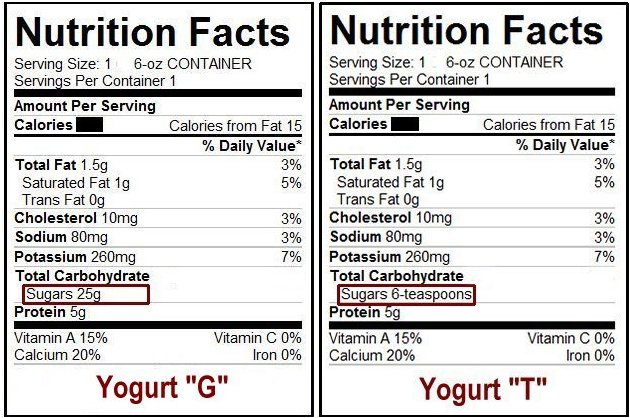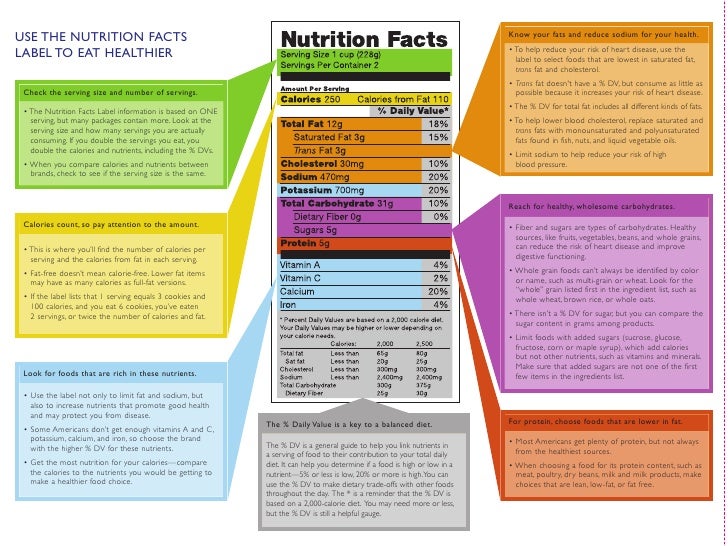39 nutritional value food labels
Food Labels | CDC Food Labels. Understanding the Nutrition Facts label on food items can help you make healthier choices. The label breaks down the amount of calories, carbs, fat, fiber, protein, and vitamins per serving of the food, making it easier to compare the nutrition of similar products. Daily Value on the New Nutrition and Supplement Facts Labels The Nutrition Facts label must list total fat, saturated fat, trans fat, cholesterol, sodium, ...
How to understand food labels - Eat For Health The Nutrition Information Panel on a food label offers the simplest and easiest way to choose foods with less saturated fat, salt (sodium), added sugars and kilojoules, and more fibre. It can also be used to decide how large one serve of a food group choice or discretionary food would be and whether it's worth the kilojoules.
Nutritional value food labels
Understanding Food Labels | The Nutrition Source | Harvard T.H. Chan ... The Nutrition Facts Label. The Nutrition Facts label is overseen by the U.S. Food and Drug Administration (FDA) and was first mandated under the Nutrition Labeling and Education Act of 1990 to help consumers make quick, informed food choices. It has undergone revisions, with the latest update released in 2016. Changes are generally based on updated scientific information and input from the public regarding ease of use. Calories on the New Nutrition Facts Label | FDA Calories refers to the total number of calories, or "energy" you get from all sources (carbohydrate, fat, protein, and alcohol) in a serving of a food or beverage. Calories Go Big Calories are now... Food Labels: Fat & Cholesterol | Home & Garden Information Center The 2015 Dietary Guidelines for Americans recommends the following intakes of fat and cholesterol every day: total fat—20 to 35% of calories, depending on age and gender (65 grams for the 2,000-calorie intake level used in the Daily Value)*. saturated fat—less than 10% of calories**. trans fat— keep as low as possible.
Nutritional value food labels. Calories for Hundreds of Foods: Your Calorie Chart Database While quality of food is important for a healthy diet, quantity is also a major factor of good nutrition. Especially for anyone concerned about maintaining or losing weight, it's a good idea to regularly review a calorie database and nutrition labels to see how much fuel you're getting to feed your daily activity - and if it's too much. Food labels - NHS Some front-of-pack nutrition labels use red, amber and green colour coding. Colour-coded nutritional information tells you at a glance if the food has high, medium or low amounts of fat, saturated fat, sugars and salt: red means high amber means medium green means low In short, the more green on the label, the healthier the choice. Nutrition labels: Finding out about the food you eat All information on the nutrition label is based on a specific amount of food, referred to as the serving size. The serving size allows you to: understand how much of a nutrient you are eating. compare nutrients and calories between two similar food products. compare the serving size on the package to the amount that you eat. How Do They Calculate Calories on Food Labels? 5 grams of fat (5 x 9 = 45 calories) 22 grams of carbohydrate (22 x 4 = 88 calories) 2 grams of protein (2 x 4 = 8) ...should contain approximately 140 calories. It's important to recognize that 4-9-4 is an average, and not an exact amount. For example, 1 gram of fat in one food may yield 8.34 calories while 1 gram of fat from another food ...
How to Decode a Nutrition Label - Healthline People with eating disorders often find that nutrition labels trigger tendencies to obsess about calories, fat, or sugar. "When examined through the lens of food-preoccupation, as in chronic ... Food Labels | Nutrition.gov What's New with the Nutrition Facts Label HHS, Food and Drug Administration The U.S. Food and Drug Administration (FDA) has updated the Nutrition Facts label on packaged foods and beverages with a fresh design that will make it easier for you to make informed food choices that contribute to lifelong healthy eating habits. What's in a Name? Nutrition Facts and Food Labels Get to know the basics of the Nutrition Facts label, and understand the parts and pieces, from serving size, total calories and fat to percent of Daily Values. Teach Your Teen about Food Panels If decoding the information on a food package is a challenge for adults, think of how hard it is for teens who are just beginning to make choices for ... How to Read Nutrition Facts Label - Food Network Literally this needs to be less than 1% of your daily calories. Foods that contain trans fats are baked goods like cakes and cookies, microwave popcorn, margarine and, of course, fried foods ...
How to Read a Nutrition Facts Label | Everyday Health "The updated nutrition facts label includes detailed information about calcium, vitamin D, iron, and potassium, simply because most Americans don't get enough of these nutrients," says Yawitz. A... Determining Nutritional Value of Foods | Home & Garden Information Center The fast way to determine which nutrients contribute a lot or a little to your daily recommended allowance is to use this guide: 5% DV or less of a nutrient is low. 20% DV or more of a nutrient is high. Low % Daily Values: You should consume foods with 5% DV or less of these nutrients often: total fat*. saturated fat. Free Nutrition Label Maker - Create and Download Nutrition Fact Labels Load a Previously Saved Label. Step 2. Choose a Nutrition Label Format. The most basic nutrition label. Vertical layout. Standard nutrition label with extra fields for misc. vitamins. Vertical layout. Tabbed nutrition label for bottles & round containers. Horizontal layout. Understanding Food Nutrition Labels | American Heart Association When the Nutrition Facts label says a food contains "0 g" of trans fat, but includes "partially hydrogenated oil" in the ingredient list, it means the food contains some trans fat, but less than 0.5 grams per serving. So, if you eat more than one serving, you could end up eating too much trans fat.
Food Labeling & Nutrition | FDA Food labeling is required for most prepared foods, such as breads, cereals, canned and frozen foods, snacks, desserts, drinks, etc. Nutrition labeling for raw produce (fruits and vegetables) and...
Understanding Nutrition Facts on Food Labels - WebMD After fats, carbohydrates, dietary fiber, sugars, and protein are listed on the food label. These items are followed by specific nutrients in the food, such as vitamin A, vitamin C, calcium, and...
PDF How Do I Understand the "Nutrition Facts" Label? a day, this is 120 calories or less, or about 13 grams of saturated fat. Most foods in the grocery store have a Nutrition Facts label and ingredient list. When you go grocery shopping, take time to read the Nutrition Facts labels on the foods you purchase. Compare the nutrients and calories in one food to those in another. The
Learn How the Nutrition Facts Label Can Help You Improve Your Health Nutrients Required on Label Vitamin D and potassium values are required. Calcium and iron will continue to be required. Vitamins A and C will no longer be required but can be included on a voluntary basis. Slight Decrease in Sodium Allowance The daily limit for sodium decreased slightly from 2,400 mg per day to 2,300 mg per day.
How to Understand and Use the Nutrition Facts Label | FDA Nutrients to get more of: Dietary Fiber, Vitamin D, Calcium, Iron, and Potassium. Dietary fiber, ...
How To Read Food and Beverage Labels | National Institute on Aging Although frozen and canned fruits and vegetables have food labels, fresh varieties often do not. You can find nutrition information for fresh vegetables and fruits on the USDA website. Or you can call the U.S. Department of Agriculture's Food and Nutrition Information Center at 301-504-5414. Understanding percent Daily Value (% DV)

What Food Manufacturers Need to Know About the FDA's New Nutrition Label - Brother Mobile Solutions
The New Nutrition Facts Label | FDA The U.S. Food and Drug Administration (FDA) has updated the Nutrition Facts label on packaged foods and drinks. FDA is requiring changes to the Nutrition Facts label based on updated scientific...
The Basics of the Nutrition Facts Label A food item with a 5% DV of fat provides 5% of the total fat that a person who needs 2,000 calories a day should eat. You may need more or less than 2,000 calories per day. This means that you may need more or less than 100% DV that is listed on the package for some nutrients. Low is 5% or less.
The Importance of Reading the Food Label and Nutritional Facts All labels provide key information about any given packaged food, such as serving size, number of calories, fat content, cholesterol, protein, sugar content, carbohydrates, etc. And of course, each label also provides a list of ingredients so you know exactly how any given food product is made.
Understanding Nutrition Labels - Medical News The nutrition label helps the health-conscious consumer to make an informed decision about the nutritional value of the food item. This also helps the consumer to avoid certain ingredients if they ...
Food Labels: Fat & Cholesterol | Home & Garden Information Center The 2015 Dietary Guidelines for Americans recommends the following intakes of fat and cholesterol every day: total fat—20 to 35% of calories, depending on age and gender (65 grams for the 2,000-calorie intake level used in the Daily Value)*. saturated fat—less than 10% of calories**. trans fat— keep as low as possible.
Calories on the New Nutrition Facts Label | FDA Calories refers to the total number of calories, or "energy" you get from all sources (carbohydrate, fat, protein, and alcohol) in a serving of a food or beverage. Calories Go Big Calories are now...
Understanding Food Labels | The Nutrition Source | Harvard T.H. Chan ... The Nutrition Facts Label. The Nutrition Facts label is overseen by the U.S. Food and Drug Administration (FDA) and was first mandated under the Nutrition Labeling and Education Act of 1990 to help consumers make quick, informed food choices. It has undergone revisions, with the latest update released in 2016. Changes are generally based on updated scientific information and input from the public regarding ease of use.








Post a Comment for "39 nutritional value food labels"